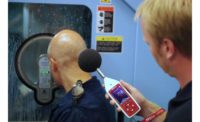Generally, are personal listening devices in the workplace a good or bad idea?
It depends. A respectable body of literature shows workers are more motivated when listening to music at work, especially in quieter, non-hazardous environments. Music masks background sounds, and improves mood and productivity. It even helps some employees with a better perception of their company.
In some situations, the use of personal listening devices (PLDs), such as iPods and other MP3 players, could be a negative or at least a concern. Communication is an obvious one. An employee listening to music may not be able to hear a supervisor’s instruction. Situational awareness — where

|
| Dr. Cory Portnuff |
anemployee must be aware of warning alerts or the sounds of operating equipment — is another.
What do the regulations say?
Nothing. There are no regulations and no standards regarding PLDs in the workplace. There aren’t even any recommendations from trade organizations or special groups. In fact, there is very little research on this topic at all.
More likely, we’ll see position statements from the National Institute for Occupational Safety and Health (NIOSH), the National Hearing Conservation Association (NHCA) or other organizations.
Currently, companies are looking to their hearing conservationist for advice. But it’s really a new topic.
What’s the starting point for employers when considering policy on personal listening devices?
There are several:
- Safety first. Is the workplace a safe place to be using PLDs? Are warning signals audible? Can safety messages be communicated? Can the worker hear and identify risk, such as the forklift backing up?
- Communication. Does the employee need to regularly communicate with coworkers or supervisors? If not, is there a way to communicate over the music?
- Job functions. At a higher level, employers need to consider what jobs could be eligible for using PLDs? Essentially, can the job be done while listening to music? Someone on the packaging line may be eligible, while a forklift driver would not. In another example, many machinists using highly specialized equipment monitor its operation partly by listening. Using a PLD removes that experience. Decide first which jobs or tasks are eligible — and then which employees are eligible after being trained to use it.
- Noise exposure with and without a PLD. Is the worker at an exposure level where they’re enrolled in a hearing conservation program? If so, will a PLD result in additional sound exposure — a sort of cumulative effect created by combining environmental background noise with the music from the PLD?
Despite good intentions, could allowing PLDs create an entirely new problem for employers — of music-induced hearing loss?
Absolutely. Any sound at high level can be damaging and music-induced hearing loss (MIHL) is a subcategory of noise-induced hearing loss (NIHL). The only reason we sometimes talk about music-induced hearing loss instead of noise-induced is because we have a general reaction that music and noise are different concepts. But that’s not based on science; it’s that we think of music as not being noise.
While there are no specifics regarding the use of PLDs, the basis of existing regulations is to protect workers’ hearing. Some companies are opting to just ignore PLDs entirely. But, if employees at work are listening to their PLDs at high levels — or for long periods of time — they could be putting themselves at risk for additional hearing loss in the form of music-induced hearing loss.
And while the regulations address noise in the environment — and don’t address MIHL on top of environmental noise — we could make the argument that anything that happens in the workplace is the employer’s responsibility. This new area is bringing a whole new level of confusion for employers.
How can employers manage the music-induced hearing loss issue?
Start with education. Before allowing workers to use PLDs, train employees in the proper operation of their device as it relates to the workplace. Set up a PLD certification that allows workers who have the education and training — and are in the appropriate job — to use their PLD. This provides the employer some control.
For employees who are not enrolled in a hearing conservation program and are not exposed to sound levels that require employer action, the education needs to be focused on the risk of MIHL they are creating with the use of a PLD and the levels of exposure that are acceptable.
For workers who are currently required to wear HPDs and have jobs permitting the use of PLDs, education and training regarding the use of PLDs and risk of MIHL must be integrated into their existing Hearing Conservation program and managed in regards to the specifics of the current HPD.
This brings up the selection of HPDs.
Right. Now to the array of noise management and ratings, comfort and fit, communications, environmental and other considerations that all combine in the process of selecting an HPD, add the availability — and effectiveness — of volume output limiters.
There’s a new generation of hearing protection devices with speakers built into earmuffs to allow the use of PLDs. Some feature volume output limiters that manage the volume that is broadcast through speakers in the ear cups. Managing the volume in order to reduce the risk for music-induced hearing loss is good practice.
But the others that don’t have a volume limiter are a big concern. With these, are we permitting one extra source of high level sound coming into a person’s ear — and does this change their exposure level?
Thinking about a worker, we focus the exposure level in their job function. If they’re exposed to 87 dB daily and we permit them to listen to music at 7 decibels above the background noise daily, where does that really put them in terms of risk?
And what’s the cumulative effect? Remember, it’s not always just how loud, but how long. The “80 for 90” rule of thumb states that 90 minutes of listening at 80 percent of a PLD’s maximum volume is usually safe from the risk of noise-induced hearing loss. But if the volume is lowered, then the listening time could be increased.
If they’re wearing a good pair of stereo earmuffs, they could still be in a safe range.
The use of personal listening devices and the risk of music-induced hearing loss in the workplace are creating some very complicated issues for employers. And we’re only just beginning — there’s a lot more work that needs to be done.


